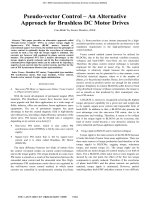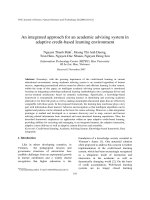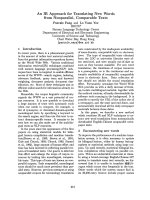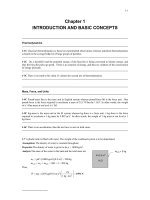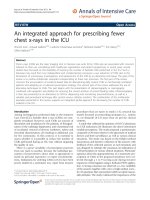Laser land levelling- an engineering approach for scientific irrigation water management in irrigation command areas of Karnataka, India
Bạn đang xem bản rút gọn của tài liệu. Xem và tải ngay bản đầy đủ của tài liệu tại đây (288.96 KB, 6 trang )
Int.J.Curr.Microbiol.App.Sci (2020) 9(5): 2393-2398
International Journal of Current Microbiology and Applied Sciences
ISSN: 2319-7706 Volume 9 Number 5 (2020)
Journal homepage:
Original Research Article
/>
Laser Land Levelling- An Engineering Approach for Scientific Irrigation
Water Management in Irrigation Command Areas of Karnataka, India
P. S. Kanannavar1*, B. D. Premanand2, B. Subhas3,
B. Anuraja3 and P. Basavaraj Bhogi4
1
(Agri. Engg.), IWMRC, Belavatagi,
University of Agricultural Sciences, Dharwad, India
2
(Agri. Engg.) (UAS Bangalore), India
3
(Agri. Engg.) (UAS Dharwad), India
4
(Agri. Engg.) (UAHS Shivamogga), India
*Corresponding author
ABSTRACT
Keywords
Resource
management, Laser
levelling, Precision
agriculture, Land
development,
Command area
Article Info
Accepted:
18 April 2020
Available Online:
10 May 2020
Management of two critical and important resources viz., Land and water in agriculture has become
a challenging task for many reasons. In rainfed and irrigated agriculture, land development plays a
key role because of undulating topography of the soil surface. It has a major impact on the
germination, water saving and crop yield. Conventional methods of land levelling are more
cumbersome and not so precise and repetitive in nature and mainly depend on the skills of the driver.
A significant (20-25 %) amount of irrigation water is lost during its application at the farm due to
poor farm design and unevenness of the field. Unscientific and excessive irrigation is leading to
degraded soil health because of water logging and salinity in almost all command areas of
Karnataka. Scientific land levelling which can give a required slope depending on the soil type,
saves irrigation water and facilitates field operation, conserves vital resources and increases the
yield. The recent technology of laser land levelling can address these important issues and help to
accomplish yield increase and agricultural sustainability in Karnataka. The studies on engineering
approach of laser land levelling technology taken up for the first time in Karnataka during 2008-09
in the jurisdiction of the University of Agricultural Sciences, Raichur highlighted considerable
reduction in drudgery of land levelling, higher levelling index, higher uniformity in soil-moisture
distribution. It was observed that 25 to 35 % increase in paddy yield and water saving (25-30%), 3040 % labour saving and 30 to 40 % saving in energy requirement in paddy cultivation.
Introduction
In agriculture, land development and
irrigation play a key role because undulating
topography of the soil surface has a major
impact on the germination, water saving and
crop yield. Irrigation is one of the agricultural
operations performed in crop production
system. India supports 17.5% of world
population with 4 % of world water resource
and 2.3% of world land area. Conventionally
farmers irrigate their crop by flooding the
2393
Int.J.Curr.Microbiol.App.Sci (2020) 9(5): 2393-2398
field i.e. surface irrigation is practiced
especially for the major crops like rice and
wheat. The irrigation efficiencies of surface
irrigation method through canal irrigated
areas are reported to be 22% in Rabi season
and 35% in Kharif season (Bosu, 2010).
Studies have indicated that significant amount
of (20-25%) of irrigation water is lost during
flooding due to poor farm designs and
unevenness of the fields. In the context of
climate change with the shrinking available
water and energy resources, judicious
application of irrigation water is of utmost
importance.
Therefore in agriculture, land development
plays a key role because undulating
topography of the soil surface has a major
impact on the germination, water saving and
crop yield. Traditional methods of land
levelling are more cumbersome and not so
precise and repetitive in nature and mainly
depend on the skills of the driver. The
technological improvements and interventions
in Indian agriculture can bring about
revolutionary
changes
in
agricultural
production.
Scientific laser levelling technology saves
irrigation water and facilitates field operation,
conserves vital resources and increases the
yield (Rickman, 2002). The latest laser
technology of land levelling was studied at
UAS Raichur. Through extension measures
the laser technology was taken to paddy
farmers of Hyderabad-Karnataka region and
found that it could address these important
issues and help to accomplish yield increase,
energy saving and agricultural sustainability.
Laser land levelling technology was
demonstrated to the farmers during
Krishimelas every year and field level
trainings. After demonstrations in paddy
fields of Upper Krishna Project (UKP) and
Tungabhadra Project (TBP) command areas
and through field level adoption. It was
observed that 25 to 35 % increase in paddy
yield and water saving (25-30%), 30-40 %
labour saving and 30 to 40 % saving in energy
requirement in paddy cultivation. Even
research findings on effect of laser land
levelling in groundnut production in respect
of crop growth, yield and water saving are
quite encouraging.
So far several thousand acres of fields are
developed with this engineering approach.
Procurement
of
laser
levellers,
experimentation in all State Agriculture
Universities (SAUs) and adoption of laser
levelling in large scale would be a successful
and significant contribution of all SAUs in the
field of Precision Agriculture in Karnataka for
enhanced water productivity.
Thus, latest resource conservation technology
(RCT) of laser land levelling in agriculture
offers a pragmatic solution to protect, manage
and effective utilization of natural resources
viz., land and water for sustainable
agriculture. In this context there is huge
opportunity and need to promote scientific
Laser technology in rainfed and especially in
all irrigated command areas of entire
Karnataka to address future challenges of
agricultural production by conserving soil and
water resources in a scientific manner.
Materials and Methods
Adoption of Laser technology in agriculture
fields of Karnataka was started with
procurement of Laser guided land leveller
from Spectra Precision Pvt., Ltd New Delhi in
the year 2008-09 by UAS Raichur. For the
first time in Karnataka a study was initiated to
find the feasibility and benefits of laser
technology in the research farms of UAS,
Raichur. A comparative evaluation of the
laser technology with the traditional method
of levelling was carried out to know Reduced
2394
Int.J.Curr.Microbiol.App.Sci (2020) 9(5): 2393-2398
Levels’ (RLs), Standard Deviation (SD),
Levelling
Indices
(LI),
Soil-moisture
Deviation (moisture SD) and Uniformity
Leveling index
Numerical difference
Coefficient (Uc). The levelling indices were
calculated using the formula given by
Agarwal and Goel (1981).
between the designed and existing grid levels
Number of grid points
The moisture contents at grid points in fields
were measured and its distribution uniformity
or Uniformity co-efficient was calculated
using Christiansen formula (Michael, 2011).
X
Cu 1001
mn
would
a successful and significant
contribution of State Agriculture universities
in the field of Precision Agriculture if it is be
taken forward to other irrigation command
areas of Karnataka for enhanced water
productivity.
Results and Discussion
Where,
Cu = Uniformity Coefficient or Moisture
distribution Uniformity in %
m = Average value of all moisture contents in
%
n = Total number of grid points
X = Numerical deviations of individual
observations
or
grid
moisture
content from the average moisture content.
After assessing the many beneficial aspects of
laser leveller, the Laser technology was
demonstrated to the several farmers during
Krishimelas and through demonstrations and
field level trainings held during every year for
helping to farming community. Fig. 1 shows
the working of Laser technology in
agricultural fields. Extension activities like
demonstrations during Krishimela and
trainings were taken up to popularize laser
technology among paddy growing farmers of
Hyderabad-Karnataka region (Fig. 2). With
extension efforts, the number of farmers
trained with demonstration of laser levelling
technology and the area levelled by laser
technology increased rapidly. UAS Raichur
provided these laser guided land levellers to
needy farmers on nominal rates for the
promotion and popularization of Laser
levelling. So far about 30000 acres of paddy
fields are levelled with Laser technology. This
After the fields were levelled traditionally and
with LASER technology (both methods of
levelling),
the
results
showed
that
considerably lower values of standard
deviations of reduced levels when the fields
were graded by use of the laser technology
Which indicates that lower the undulations in
the Laser Levelled field as compared to
traditional levelling field (Table 1). Similarly,
the considerable decrease in the standard
deviations (SD) of RLs as well as levelling
indices (LI) and uniform distribution of the
soil moisture over the entire field was
achieved with laser technology (Anuraja et.
al., 2013). This showed that the precision and
quality of levelling operation increased with
laser technology for land development where
as it depended on individual’s skills of the
operator in traditional land development. The
uniformity of soil-moisture distribution on the
laser levelled and traditional levelled fields
were found as 93.63 % and 74.41 %,
respectively. Laser technology has been
demonstrated in krishimelas and popularized
by several field level trainings (Table 2). The
studies on laser technology for land
development in the jurisdiction of the
University of Agricultural Sciences,(UAS)
Raichur highlighted considerable reduction in
drudgery of land levelling, higher levelling
2395
Int.J.Curr.Microbiol.App.Sci (2020) 9(5): 2393-2398
index, uniformity in soil-moisture distribution
(95-98 %), irrigation time and water saving
(25-30 %). Similar findings were reported by
Rajput et al., (2004), Jat et al., (2005) and
Aggarwal et al., (2010). After demonstrations
to the several farmers of Upper Krishna
Project (UKP) and Tungabhadra Project
(TBP) during Krishimelas, in farmers’ fields
and through field level adoption of Laser
technology for land development, it was
observed that 25 to 35 per cent increase in
paddy yield as well as saving in man power
and 30 to 40 per cent saving in energy
requirement in paddy cultivation (Table 3). So
far more than 40 units of Laser land levellers
being owned by the farmers of UKP and TBP
areas indicating it as the farmer friendly
technology for paddy cultivation.
Table.1 Research findings from fields before and after adoption of Laser land levelling
technology for land development
Parameters
Values
Traditional levelling
100
60
6000
22.63
Laser levelling
Length of field, m
100
Width of field, m
60
2
Area of field, m
6000
Standard deviation, cm before levelling (10 21.47
mx10 m grids)
Standard deviation, cm after levelling (10 3.07
mx10 m grids)
levelling index before levelling, cm
9.67
12.04
11.69
levelling index after levelling, cm
1.22
6.69
Uniformity coefficient, %
93.63
74.41
Table.2 Trainings /demonstrations on Laser land levelling technology to paddy farmers
Sl.
Place /Event
No.
1 UAS Raichur Training
2011-12
No. of
farmers
30.01.2012 88
2
UAS Raichur, Krishimela
2012-13
01.12.2012 818
3
UAS Raichur, Krishimela
2013-14
05.10.2013 1070
4
Field demonstration at Puchaladinni, Tq. Raichur
2013-14
24.08.2013 60
5
UAS Raichur, Krishimela
2014-15
14.11.2014 451
6
University Level Training at Sindhanur
2014-15
14.02.2015 39
7
UAS Raichur, Krishimela
2015-16
30.01.2016 513
8
UAS Raichur, Krishimela
2016-17
05.11.2016 378
Year
2396
Date
Int.J.Curr.Microbiol.App.Sci (2020) 9(5): 2393-2398
Table.3 Overall advantages of Laser land levelling technology (with feedback from farmers)
Particulars
Increase in cultivable land
Saving in fertiliser usage
Water saving
Labour saving
Increase in yield
Energy saving
Values, %
3 to 5
25 to 30
25 to 30
45 to 50
25 to 35
30 to 40
Fig.1 Working of Laser land levelling Technology for Agriculture land development
Fig.2 Trainings and demonstrations of Laser land levelling technology
After encouraged by the beneficial impacts of
this Laser levelling technology in different
states of the Northern India the number of
Laser levellers increased more than 13000
but in Karnataka these are still less than 50
until now. So there is huge opportunity to
popularise this farmer friendly technology in
all the irrigation command areas of
Karnataka. The overall benefits of Laser land
levelling technology for levelling are increase
2397
Int.J.Curr.Microbiol.App.Sci (2020) 9(5): 2393-2398
in cultivation area, yields and water use
efficiency, reduction in time and water
requirement for Irrigation, better and uniform
crop establishment, saving of fuel and energy,
easy crop management as well as decreased
drudgery.
Acknowledgement
Authors are grateful to staff of College of
Agricultural Engineering and officers of
University of Agricultural Sciences, Raichur
in helping to initiate and popularize this Laser
land levelling technology in farmers’ fields
with
all
support,
cooperation
and
encouragement. Authors also express their
gratitude to the farmers who came forward in
demonstration and adoption of Laser land
levelling technology and sharing their
opinions.
References
Agarwal, M.C. and Goel, A.C., 1981, Effect
of field levelling quality on irrigation
efficiency and crop yield. Journal of
Agricultural Water Management, 4:
457–464.
Aggarwal, R., Samanpreetkaur and Amarjeet
Singh., 2010, Assessment of saving in
water resources through precision land
levelling in Punjab. Journal of Soil and
Water Conservation, 9(3): 182-185.
Anuraja, B., Kanannavar, P. S., Balakrishnan,
P., Pujari, B. T. and Hadimani, M. B.,
2013,
Laser guided land leveller for
precision land development. Karnataka
Journal of
Agricultural Sciences,
26(2): 271-275.
Jat, M. L., Sharma, S. K., Gupta, R. K.,
Kuldeep, S. and Parvesh, C., 2005,
Laser land
levelling- The Precursor
Technology for Resource Conservation
in Irrigated Ecosystem of India,
Conservation Agriculture-Status and
Prospects. Centre for Advancement of
Sustainable Agriculture, New Delhi. pp.
145-154.
Michael, A. M., 2011, Irrigation Theory and
practice,
second
edition,
Vikas
publishing
House Pvt. Ltd., Noida201301 (UP), India, pp: 398-399.
Rajput, T. B. S., Patel, N. and Agrawal, G.,
2004, Laser levelling- a tool to increase
irrigation
efficiency at field level.
Journal of Agricultural Engineering,
41(1): 20-25.
Rickman, J.F., 2002, “Manual for laser land
leveling”. Rice-Wheat Consortium
Technical
Bulletin Series 5. New
Delhi–110 012, India: Rice-Wheat
Consortium for the IndoGangetic
plains, p. 24.
Santhana Bosu, S. 2010, Engineering
Interventions for Food Security in
Rainfed Areas.
Lead Paper
presented in the National Seminar on
Engineering
Agriculture
for
Evergreen revolution held at S.V.U.
Tirupati by ISAE (AP Chapter) during
24-25
September.
How to cite this article:
Kanannavar, P. S., B. D. Premanand, B. Subhas, B. Anuraja and Basavaraj Bhogi, P. 2020.
Laser Land Levelling- An Engineering Approach for Scientific Irrigation Water Management
in Irrigation Command Areas of Karnataka, India. Int.J.Curr.Microbiol.App.Sci. 9(05): 23932398. doi: />
2398

